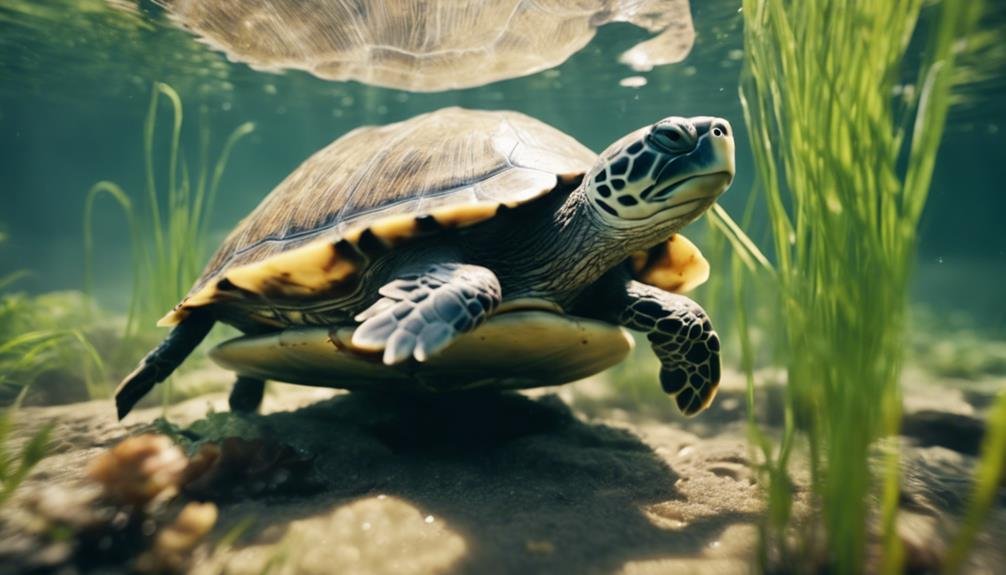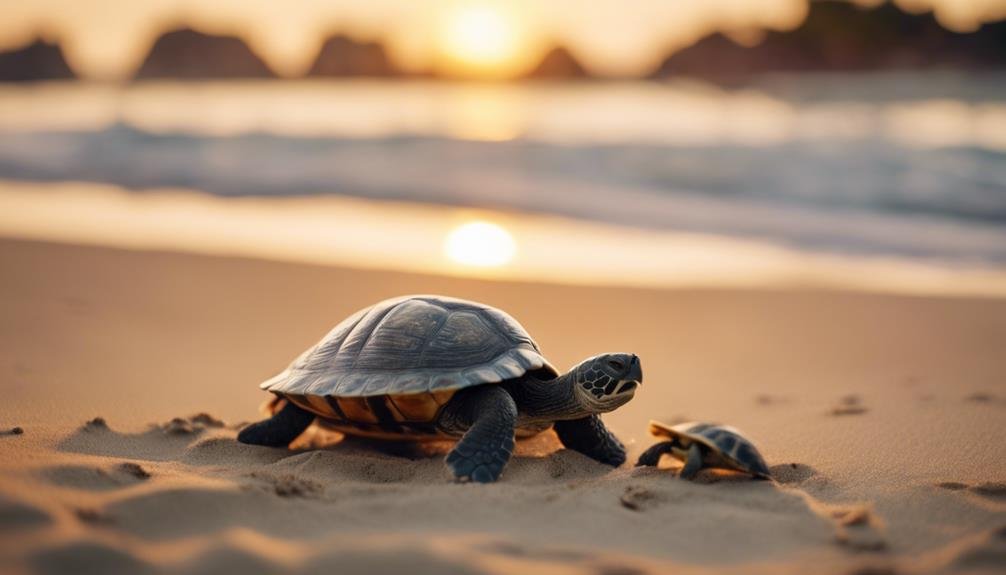As you explore the world of turtles, you might find yourself intrigued by how these seemingly serene creatures approach the intricate task of mating. While you’re aware that mating rituals vary widely across different species, turtles have a particularly fascinating method involving a mix of gentle courtship and at times, surprisingly aggressive behaviors. For instance, male turtles often engage in shell biting and forceful mounting, which are essential for successful copulation. But what prompts these behaviors and how do females respond to such advances? Understanding these dynamics not only sheds light on their survival strategies but also highlights the challenges they face during these vulnerable moments. Let’s investigate what drives these rituals and how they impact turtle populations worldwide.
Key Takeaways
- Turtles mate by the male mounting the female, often using physical force.
- Males align their cloaca with the female’s to transfer sperm.
- During mating, male turtles may bite the female’s head and legs.
- Copulation can last several hours, with the female often dragging the male around.
- Mating generally occurs in water for aquatic turtles and on land for terrestrial species.
Turtle Species and Mating Differences
Different turtle species exhibit a range of mating behaviors, with variations evident across habitats and seasons. For example, box turtles, typically found in forests, grasslands, and wetlands, have their unique timing and style. They primarily mate in the spring and summer, often after thunderstorms, which seem to ignite their mating instincts. You might find them engaging in copulation in their water dishes—a peculiar choice, but quite common among these turtles.
During mating, the male box turtle often exhibits aggressive behaviors. He may bite the female on her shell to hold her in place, a process that can last up to three hours. This extended duration isn’t just about the act itself but also ensures that the male successfully transfers his sperm to the female’s cloaca, which is pivotal for fertilization. This point of contact is critical; the male aligns his tail with the female’s cloaca, ensuring that copulation is successful.
Now, if you were observing Green sea turtles, the scenario shifts slightly. The males use their front flippers to grasp the female around the shell, a method adapted to their aquatic life, highlighting how different environments influence mating strategies across turtle species.
Courtship Rituals Explained
In sea turtle courtship, males engage in gentle biting of the female’s neck and flippers to initiate the mating process. These rituals aren’t just about attraction, they’re an essential part of how sea turtles prepare for mating. Unlike many other creatures, sea turtles have a unique set of behaviors that guarantee the female is ready and the male’s efforts aren’t interrupted by competitors.
Here’s what you need to know about sea turtle courtship:
- Location and Duration: Courtship often occurs right at the surface or just underwater. It can last several hours, during which the male must keep other potential suitors at bay, securing his chances with the female.
- Reproductive Details: Both male and female sea turtles have their reproductive organs located at the base of their tails, in a part called the cloaca. This anatomical setup is crucial for the mating process which follows the courtship.
- Sperm Storage: Females have the ability to store sperm from multiple males, which means that even after the courtship rituals, the competition can continue at a genetic level as eggs can be fertilized by different males’ sperm stored from previous courtships.
Understanding these rituals sheds light on the complex reproductive strategies of sea turtles, highlighting how every step from courtship to mating is interconnected and crucial for their survival.
The Mating Process


Once the courtship is complete, male turtles typically mount the females aggressively to begin the mating process. This isn’t just a quick affair; mating among sea turtles can last for several hours. You might find it surprising, but during copulation, females often drag their suitors around, which is quite a sight in the marine setting!
During these intense sessions, the male’s behavior can be quite aggressive. They often bite the female’s head and legs, which might seem harsh, but it’s an essential part of their mating ritual. Copulation occurs when the male aligns his cloaca—an organ used for reproduction and excretion—with that of the female. This alignment is necessary for the transfer of sperm, which will later fertilize the female’s eggs.
Despite the roughness of their initial approach, this process is fundamental for the continuation of their species. So, as you watch these majestic creatures in the sea, remember that their aggressive mating behavior plays an important role in their lifecycle, ensuring the survival of future generations of sea turtles.
Challenges During Mating
Mating for sea turtles presents important challenges, as females may risk drowning when multiple males compete aggressively for mating rights. Imagine you’re a female sea turtle during this critical time. Not only do you face the challenging task of managing the overwhelming attention from males, but you must also navigate through several physically demanding situations.
Here are the top three challenges you’d encounter:
- Aggressive Competition: The mating process is complicated by the fact that multiple males compete, often violently, for your attention. This aggressive competition can lead to physical exhaustion and even injuries, making it a perilous time for you.
- Weight Support: During copulation, you have to support not just your own weight but also that of the male. This is especially challenging in water, where despite the buoyancy, the added weight can significantly hinder your movement and even breathing.
- Endurance Test: The entire mating process is incredibly physically demanding. Besides the struggle to fend off unwanted suitors, the act of copulation itself can last for hours, requiring you to have exceptional stamina and strength.
As you navigate these challenges, your ability to manage and overcome them is important for successful mating and, ultimately, the survival of your species.
Nesting and Egg Laying


After overcoming the intense challenges of mating, you must now focus on the critical task of nesting and egg laying. As a female sea turtle, you have the unique ability to lay multiple clutches of eggs during a single nesting season. This strategy enhances your chances of reproductive success.
You’ve been fertilized by multiple males, ensuring the genetic diversity of your offspring. Now, vulnerable on land, you use your back and front claws to dig a deep sand chamber. The design of your shell and the strength in your tail aid you in meticulously crafting this safe space for your future hatchlings.
You deposit anywhere from 70 to 125 eggs into this chamber, depending on your species. Each of these eggs represents a potential new life, fertilized during the complex mating process where males competed to align their cloacas with yours. After the exhaustive effort of laying eggs, you cover them carefully with sand to protect them from predators and environmental extremes.
Do Turtles Mate in the Same Way as Other Animals Given Their Physical Limitations?
Turtles’ jumping abilities are limited due to their physical structure, but they do mate in a similar way to other animals. Male turtles use their claws to grip the female’s shell during mating, while some species even display intricate courtship rituals. Despite their restricted jumping abilities, turtles have adapted unique methods for reproduction.
Protecting Mating Grounds
To guarantee the survival of their species, turtles rely heavily on the protection of their mating grounds. During mating season, male and female turtles engage in a delicate dance of courtship before copulation. Their reproductive success largely depends on undisturbed environments where they can safely find partners and mate. The male uses his tail to position his cloaca—an essential reproductive organ—near the female’s to transfer sperm effectively. The protection of these vital areas isn’t just beneficial; it’s indispensable.
Here’s what you can do to help:
- Support Local Conservation Efforts: Engage with and donate to organizations that work tirelessly to preserve natural habitats. Your support helps fund the protection and restoration of vital mating grounds.
- Reduce Pollution: Simple actions like reducing plastic use and participating in beach clean-ups can decrease pollution that disrupts turtle mating activities. Every little bit helps in keeping their environment safe and clean.
- Educate Others: Sharing knowledge about the importance of these ecosystems can inspire others to act. Awareness leads to action, and more voices can make a louder call for change.
Conclusion
As you’ve seen, turtles have unique mating rituals, from distinct courtship behaviors to the physical mating process itself. These practices can pose challenges, including the physical strain on females and risks from aggressive male competition.
Understanding these behaviors not only fascinates but also underscores the importance of protecting their mating grounds. By ensuring these areas are safe, you’re helping secure the future for these remarkable creatures and their intricate life cycles.


